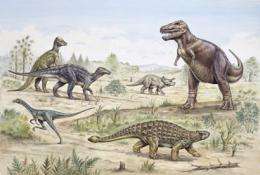Dinosaurs declined before mass extinction

Dinosaurs were dying out much earlier than the mass extinction event 65 million years ago, Natural History Museum scientists report in the Proceedings of the Royal Society journal today.
The diversity of dinosaur species was already on the decline millions of years before this event. This changes the current theory about how and when dinosaurs became extinct.
'It appears that dinosaurs were declining well before the famous meteor impact,' says Paul Barrett, part of the research team and dinosaur expert at the Natural History Museum.
'The impact may have been the coup de grace that helped to finish off a group that was already in trouble for another reason.'
Common mass extinction theory
Until now, the common theory was that all dinosaurs, except the ancestors of birds, were wiped out at one time, perhaps by a huge meteorite, at the end of the Cretaceous period. Many dinosaur species such as Triceratops were wiped out abruptly around this time. However, this does not tell the full story.
Barrett and his team found that most species, such as those in the theropod group, like Baryonyx and T.rex, had already declined millions of years earlier.
This discovery was made while Barrett and his colleagues were studying how species diversity shows itself in the fossil record.
By studying species preserved as fossils in rocks, palaeontologists (fossil experts) can reveal what creatures lived in the past and major events that may have happened, such as mass extinctions.
However, the fossil record is not perfect. There are gaps and fossils can also be altered by geological processes. Erosion, burial and subduction (when plates slide under other plates) all help to destroy the fossil record.
Rock and diversity relationship
Barrett and his team's results uncovered a relationship between the amount of fossil-containing rock available and the pattern of species diversity. In general, the more rock available, the higher the diversity uncovered.
The diversity decline at the end of the Cretaceous was at a time in Earth's history when plenty of rock and fossils were preserved. So the high amount of available rock from this time should have shown a high diversity of dinosaurs if there was one. But it didn't.
'Our work shows for the first time that the number of different types of dinosaur was declining well before their final extinction, in spite of the fact the amount of rock available for preserving dinosaurs was at its peak.'
Barrett concludes, ‘The fossil record of dinosaurs continues to give us new surprises, even after 150 years of concentrated study’.
More information: Proceedings of the Royal Society, Biological Sciences
Provided by American Museum of Natural History (news : web)


















